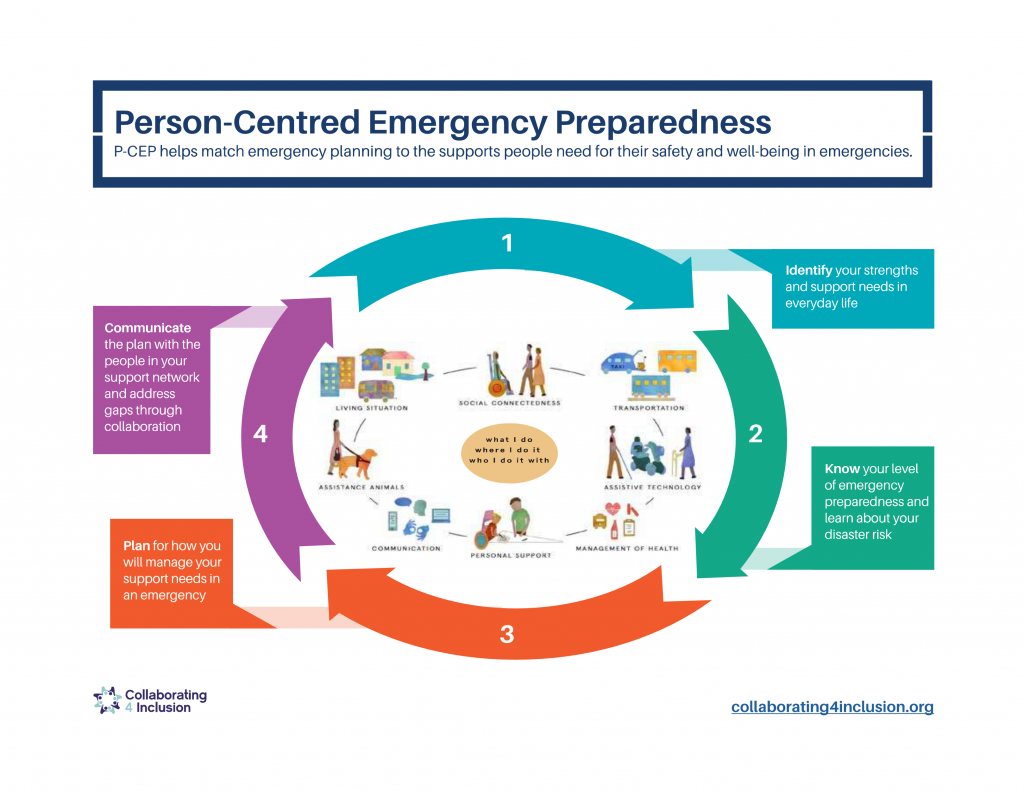Emergency Preparedness: Building on Your Everyday Strengths
You’re Already Prepared – Let’s Build on That
Every day, you navigate challenges, solve problems, and adapt to changing situations. These are the same strengths that will help you prepare for and respond to emergencies. Emergency preparedness isn’t about starting from scratch – it’s about recognising what you already do well and building on those capabilities.
Emergency preparedness is a process, not a one-time event. The goal is to create realistic plans that work for you, your household, and the people who matter to you.
1: Recognise Your Everyday Strengths
The Capability Wheel: Eight Areas of Daily Life

Think about how you manage these eight areas:
Communication:
- How do you usually receive important information?
- What devices or methods do you rely on to stay connected?
- Who do you trust for reliable information?
Health Management:
- What medications, treatments, or equipment do you need?
- Who helps you manage your health?
- Where do you get your medical supplies?
Personal Support:
- Who assists you with daily activities?
- What type of support do they provide?
- How do you organise your care?
Transportation:
- How do you usually travel around the Huon Valley?
- Who helps you get to important places?
- What happens when your usual transport isn’t available?
Living Situation:
- What makes your home safe and accessible for you?
- Who do you live with?
- What services (power, water, internet) do you rely on?
Social Connections:
- Who can you count on for help?
- Who counts on you?
- How do you stay connected with important people?
Assistive Technology:
- What devices or equipment do you use daily?
- What power sources do they need?
- How do you maintain or repair them?
Assistance Animals/Pets:
- What animals depend on you?
- What do they need for their care and safety?
- Who can help you care for them if needed?
Reflection Activity:
Take a moment to think about your strengths in each area.
- What do you do independently?
- What support do you receive?
- Who are the key people in your network?
2. Assess Your Current Emergency Preparedness
Where are you on your preparedness journey?
- Haven’t thought about it – That’s okay, you’re starting now.
- Thought about it but not yet acted – You’re aware, ready for next steps.
- Started to get organised – You’ve begun, let’s build on that.
- Have taken actions to get ready – Great progress, let’s refine your plan.
- Reviewed actions and told others – Excellent, you’re helping others too.
Understanding Your Risks
Before you can make your emergency plan, you should understand the specific risks that are likely to affect you, your household, and your business.
Once you understand your biggest risks, you can then develop your emergency plan.
To get started:
- Visit our Understand your risk page and explore the various types of disasters and resources to assess your risk based on the location of your home or business.
Check your specific risks:
- Review the Community Protection Flood Guides for your area.
- Review the Community Bushfire Protection Plans for your area.
- View the Tasmanian Strategic Flood Maps for detailed information about local flood risks.
- Search RiskReady to identify the natural hazards affecting your property.
3. Make Your Emergency Plan Fit Your Life
Effective emergency planning considers two main scenarios:
Scenario 1: Staying at Home (Shelter-in-Place)
What if you had to stay home for up to 7 days without normal services and supports?
Scenario 2: Leaving Home (Evacuation)
What if you had to evacuate to a safe place? Where would you go? How would you manage your needs?
Tailoring Your Plan to Your Capabilities
Using the eight capability areas, consider:
For each area, ask yourself:
- How would I manage this if I had to stay home without power/services?
- How would I manage this if I had to leave home quickly?
- What gaps exist in my current planning?
- Who can help me address these gaps?
Essential Planning Elements
Stay Home Plan includes:
- Water (3 litres per person per day for at least 3 days)
- Non-perishable food and manual can opener
- Battery-powered radio and torches
- First aid kit and essential medications
- Blankets and warm clothing
- Backup power for essential equipment
- Communication methods when phones/internet fail
Evacuation Plan includes:
- Multiple safe places you could go
- Transportation arrangements
- Essential items you must take
- Care arrangements for pets/assistance animals
- Important documents in waterproof storage
- Emergency contacts who know your plan
Special Considerations:
- Medication that needs refrigeration
- Equipment that requires power
- Mobility aids and assistive devices
- Communication needs
- Personal care requirements
- Pet and assistance animal needs
4. Share Your Plan and Fill the Gaps
Your emergency plan only works if others know about it.
Who needs to know your plan?
- Family members and close friends
- Support workers and service providers
- Neighbours who might assist you
- Healthcare providers
- Pet care providers
Working Together to Fill Gaps
Emergency preparedness is most effective when it’s a community effort. Consider:
- What gaps exist in your plan that you can’t address alone?
- Who in your support network can help fill these gaps?
- What community resources are available?
- How can you contribute to others’ preparedness?
Regular review and updates:
- Review your plan every six months
- Update contact information
- Check emergency kit supplies
- Practise your plan with household members
- Adjust based on changes in your needs or circumstances
5. Resources and Support
Emergency Information
- Emergency Services: 000 (Police, Fire, Ambulance)
- SES (Floods/Storms): 132 500
- TasALERT App: Download for current emergency information
- ABC Local Radio: Your emergency broadcaster
- National Relay Service: 133 677
- Translating and Interpreting Service (TIS National): 131 450
Planning Tools
- Tasmania SES Get Ready for Emergencies Guide
- Person-Centred Emergency Preparedness Workbook
- Red Cross RediPlan
- Tasmania Fire Service My Bushfire Plan
- Business Tasmania Emergency Toolkit
- Primary Industry Flood Readiness Toolkit
Community Support
- Huon Valley Council Emergency Management Team
- Local community groups and neighbours
- Local Service providers and Huon Valley Service Providers Network
- The Right Place and other health professionals
- People with Disability Emergency Preparedness Project
Remember: You’re Not Alone
Emergency preparedness in the Huon Valley is a shared responsibility. While you’re responsible for your own planning, our community works together to ensure everyone can be as safe and prepared as possible.
Your preparation helps everyone:
When you’re prepared, emergency services can focus on those who need immediate assistance, and our whole community becomes more resilient.
Start small, build gradually:
You don’t need to do everything at once. Pick one area to focus on this week, then build from there.
Ask for help:
If you’re unsure about any aspect of emergency planning, contact Council’s Emergency Management team or speak with your support providers.
Take Action Today
- Identify your priority capability areas using the wheel above
- Assess your current preparedness level (1-5 scale)
- Start with one small step – perhaps downloading the TasALERT App or checking your emergency kit
- Share this page with someone in your support network
- Plan a household emergency conversation for this week
Emergency preparedness is a journey, and every step makes you and our community safer and more resilient.

